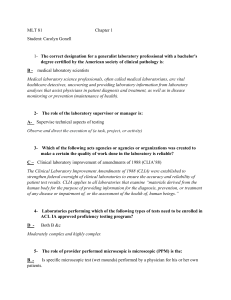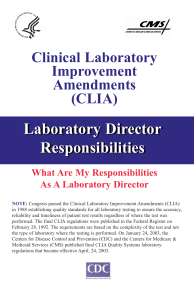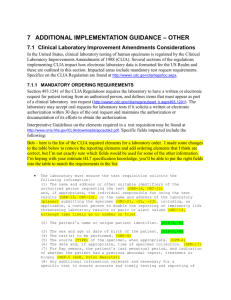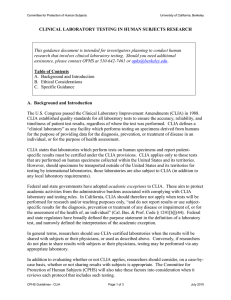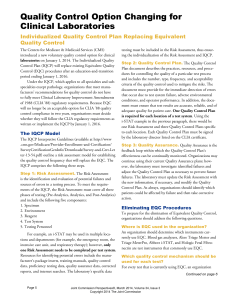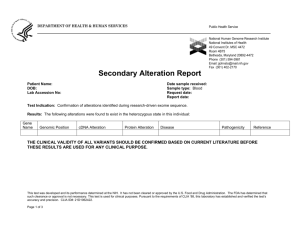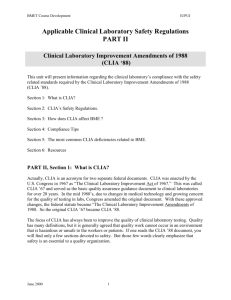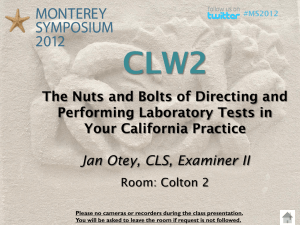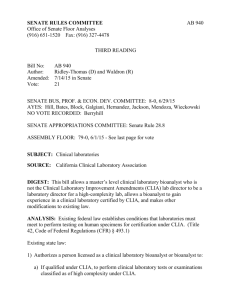QA Manager Position Description NC
advertisement
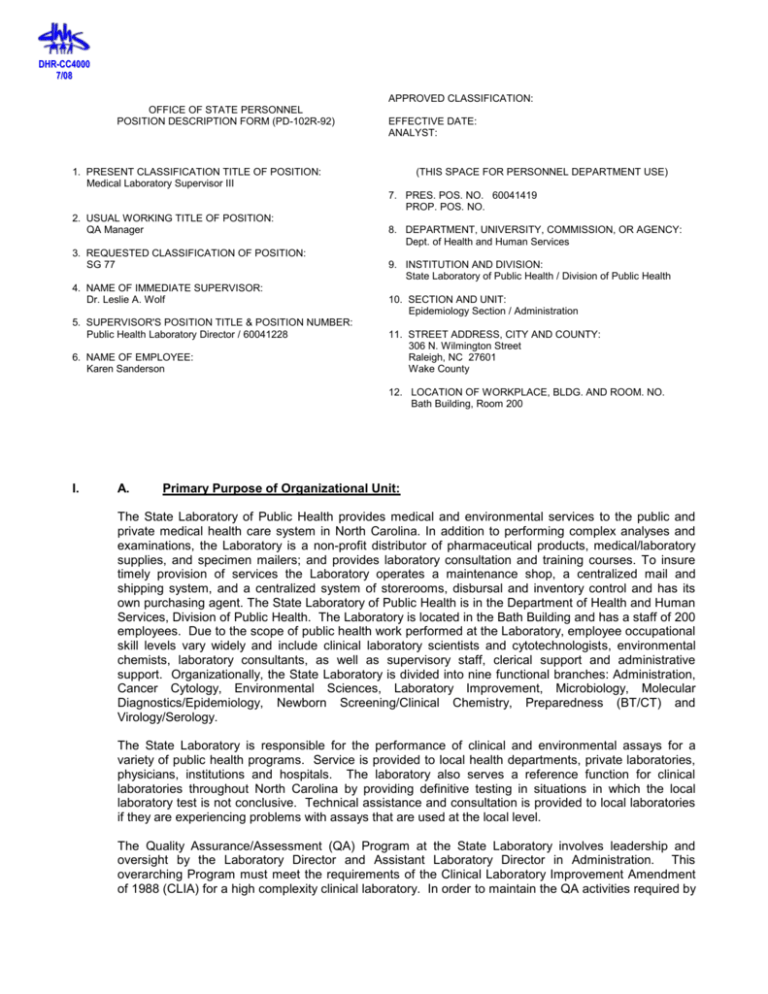
DHR-CC4000 7/08 APPROVED CLASSIFICATION: OFFICE OF STATE PERSONNEL POSITION DESCRIPTION FORM (PD-102R-92) EFFECTIVE DATE: ANALYST: 1. PRESENT CLASSIFICATION TITLE OF POSITION: Medical Laboratory Supervisor III (THIS SPACE FOR PERSONNEL DEPARTMENT USE) 7. PRES. POS. NO. 60041419 PROP. POS. NO. 2. USUAL WORKING TITLE OF POSITION: QA Manager 3. REQUESTED CLASSIFICATION OF POSITION: SG 77 4. NAME OF IMMEDIATE SUPERVISOR: Dr. Leslie A. Wolf 5. SUPERVISOR'S POSITION TITLE & POSITION NUMBER: Public Health Laboratory Director / 60041228 6. NAME OF EMPLOYEE: Karen Sanderson 8. DEPARTMENT, UNIVERSITY, COMMISSION, OR AGENCY: Dept. of Health and Human Services 9. INSTITUTION AND DIVISION: State Laboratory of Public Health / Division of Public Health 10. SECTION AND UNIT: Epidemiology Section / Administration 11. STREET ADDRESS, CITY AND COUNTY: 306 N. Wilmington Street Raleigh, NC 27601 Wake County 12. LOCATION OF WORKPLACE, BLDG. AND ROOM. NO. Bath Building, Room 200 I. A. Primary Purpose of Organizational Unit: The State Laboratory of Public Health provides medical and environmental services to the public and private medical health care system in North Carolina. In addition to performing complex analyses and examinations, the Laboratory is a non-profit distributor of pharmaceutical products, medical/laboratory supplies, and specimen mailers; and provides laboratory consultation and training courses. To insure timely provision of services the Laboratory operates a maintenance shop, a centralized mail and shipping system, and a centralized system of storerooms, disbursal and inventory control and has its own purchasing agent. The State Laboratory of Public Health is in the Department of Health and Human Services, Division of Public Health. The Laboratory is located in the Bath Building and has a staff of 200 employees. Due to the scope of public health work performed at the Laboratory, employee occupational skill levels vary widely and include clinical laboratory scientists and cytotechnologists, environmental chemists, laboratory consultants, as well as supervisory staff, clerical support and administrative support. Organizationally, the State Laboratory is divided into nine functional branches: Administration, Cancer Cytology, Environmental Sciences, Laboratory Improvement, Microbiology, Molecular Diagnostics/Epidemiology, Newborn Screening/Clinical Chemistry, Preparedness (BT/CT) and Virology/Serology. The State Laboratory is responsible for the performance of clinical and environmental assays for a variety of public health programs. Service is provided to local health departments, private laboratories, physicians, institutions and hospitals. The laboratory also serves a reference function for clinical laboratories throughout North Carolina by providing definitive testing in situations in which the local laboratory test is not conclusive. Technical assistance and consultation is provided to local laboratories if they are experiencing problems with assays that are used at the local level. The Quality Assurance/Assessment (QA) Program at the State Laboratory involves leadership and oversight by the Laboratory Director and Assistant Laboratory Director in Administration. This overarching Program must meet the requirements of the Clinical Laboratory Improvement Amendment of 1988 (CLIA) for a high complexity clinical laboratory. In order to maintain the QA activities required by 2 regulatory agencies and good laboratory practices, the QA Manager provides guidance, consultation, and oversight to Technical and General Supervisors and other laboratory staff. B. Primary Purpose of Position: The QA Manager directs activities of the Clinical QA Coordinator and Laboratory Safety Officer. The clinical Quality Assurance/Assessment (QA) Program must meet the requirements of the Clinical Laboratory Improvement Amendment of 1988 (CLIA) for a high complexity clinical laboratory, The QA Manager works with the Environmental Sciences Manager to ensure that the QA activities of the Environmental Sciences Unit meets the requirements of the Food and Drug Administration (FDA) for the grade A dairy program, and the Environmental Protection Agency (EPA) for environmental testing. Monthly reports and the results of annual audits will be provided to Administration as records that the clinical laboratories are continuously monitoring and improving the laboratory systems utilized to provide patient test results. The QA Manager’s high level review, development of recommendations and corrective actions, and follow- up on implementation of approved recommendations are critical to maintaining a robust and dynamic QA Program at the State Laboratory. In order to maintain the daily, weekly, monthly, semi-annual and annual QA activities required by CLIA, the QA Program Manager, and Clinical QA Coordinator provide guidance, consultation and oversight to Technical and General Supervisors in the clinical laboratories. Frequent meetings with Technical and General Supervisors will be held to discuss routine monitors, problems and complaints that have surfaced during the month and will require that written minutes and formal reports be provided to the Assistant Laboratory Director and Laboratory Director. Annual audits of testing and workflow processes will be performed annually for each Unit. In addition, focused audits will be performed as needed. This high level review will ensure that continuous monitoring and improvement of the laboratory systems utilized to provide patient test results occurs in all clinical areas. The QA Manager will review the State Laboratory QA plan and Unit QA plans at least annually, or as CLIA regulations change, and make recommendations to Administration. The Clinical QA Coordinator will coordinate with the QA Program Manager in analyzing laboratory wide trends that may result in misdirected reports, corrected reports, delayed turnaround times and other customer service issues. The Safety Officer will work with the QA Manager to provide a complete and effective safety program for the laboratory. C. Work Schedule: Work hours are flexible between the hours of 7:30 and 5:30. Occasional travel and special projects may require longer hours, but flex time may be used in these cases. D. Change in Responsibilities or Organizational Relationship: The QA Manager is now responsible for QA activities in the clinical lab Units. The QA Manager works with the Environmental Sciences Manager to ensure QA and regulatory activities are maintained in the Environmental Sciences Unit. The Chemist III position, previously under direction of the QA Manager, has been reassigned to Environmental Sciences. The QA Manager now supervises the Laboratory Safety Officer (Laboratory Improvement Coordinator) and Clinical QA Coordinator (Laboratory Improvement Coordinator). QA Manager Position Description 3 II. A. Description of Responsibilities and Duties: Method Used (Check One) Order of Importance Sequential Order Place an asterisk (*) next to each essential function. (See instructions for complete explanation.) Please note percentage of time for each function. 1. *(50%) Directs the Clinical QA Coordinator in general oversight and direction of State Laboratory QA efforts in the following laboratory Units: Cancer Cytology, Laboratory Improvement, Microbiology, Molecular/Epidemiology, Newborn Screening/Clinical Chemistry, Preparedness (BT/CT) and Virology/Serology. The oversight and direction activities should address, but are not limited to, the following topics: a. Personnel Assessment b. Quality Control and Analytic Systems c. Patient Test Management (pre-analytic and post-analytic systems) d. Proficiency Testing e. Comparison of Test Results f. Relationship of Patient Information to Patient Test Results g. Communications h. Complaint Investigations i. Quality Assessment Review with staff j. Quality Assessment Records, particularly ensuring uniformity across Units k. Method Verifications and Validations l. QA Monitors and Special Studies 2. * (15%) Perform internal and focused audits of each clinical laboratory unit with assistance from the QA Clinical Coordinator. Makes recommendations to Technical and General Supervisors, as well as to the Assistant Lab Director and Laboratory Director, to improve upon weaknesses identified during the audit. Audits also should include review of communication and problem logs in each Unit, as well as recommendations and follow up actions. 3. * (15%) Plan and lead the Laboratory QA Team meetings each month. Provide minutes from meetings with Technical and General Supervisors of clinical laboratory Units and generate monthly reports for review by the Assistant Laboratory Director and Laboratory Director. The reports should reflect new, ongoing and follow up activities in each area related to Quality System Essential elements. 4. * (5%) Review and modify the State Laboratory QA Plan and Unit QA Plans at least annually, or as CLIA regulations change, to ensure that plans are in compliance with the current regulations. 5. * (5%) Oversee the CLIA survey process, including pre-survey preparation and follow-up on any corrective actions. Ensure that the CLIA certification is kept current. 6. *(5%) Direct the activities of the Laboratory Safety Officer to ensure that the laboratory’s safety and chemical hygiene programs comply with all federal, state, and local regulations applicable to a clinical and environmental testing laboratory. 7. * (5%) Maintain up-to-date knowledge regarding federal regulations that affect clinical laboratories. Provide QA workshops, training materials, literature, checklists and other tools to assist the Technical and General Supervisors in meeting federal regulations. QA Manager Position Description 4 II. B. Other Position Characteristics: 1. Accuracy Required in Work: This position requires exceptional accuracy and attention to detail. Because the State Laboratory is a large environmental, clinical and reference laboratory, it is necessary for this position to develop and/or utilize checklists to ensure that all QA documentation and records are in place on at least a monthly, semi-annual and annual basis. Failure to note and report a laboratory’s lack of required documentation during audits may lead to serious deficiencies during the biennial CLIA inspection. 2. Consequence of Error: QA deficiencies can lead to increased turnaround time for laboratory results, erroneous laboratory results, increased costs of repeated specimen collection and testing, as well as other outcomes that adversely affect patient care and submitter satisfaction. Failure to spot deficiencies in the QA Program can lead to standard or condition level deficiencies by federal CLIA inspectors. These deficiencies must be corrected, and documented as to how they were corrected, within a very short time frame. If severe deficiencies are noted during the biennial CLIA inspections, it is possible the laboratory could be closed for a period of time. 3. Instructions Provided to Employee: Employee is provided with an orientation to the State Laboratory of Public Health, as well as required training (Safety, Blood Borne Pathogen, Customer Service, HIPPA, Workplace Harassment) and policies in effect at the Laboratory, Division and Department levels. After initial orientation, development of a work plan with the supervisor will provide an outline of key responsibilities and clarify expectations for the duties of the position. 4. Guides, Regulations, Policies, and References Used by Employee: Publications from APHL, CDC/LRN, FDA, OSHA, CLSI, CMS/CLIA and other organizations/agencies are used as references to particular policies and procedures and to keep current with laboratory regulations. Knowledge of a wide variety of public health programs’ guidelines is necessary to determine the adequacy of laboratory tests to meet program objectives and to integrate program objectives into the laboratory operations. Computer websites, peer journals and other professional publications keep the QA Manager updated on new technologies, quality improvement tools, and changes in the laboratory field. Conference calls, APHL training, web communications, and meetings assist with communication of QA and LIMS issues with public health partners. 5. Supervision Received by Employee: This position is expected to perform in a professional manner with minimal to no routine supervision. Once a year, the Laboratory Director performs a performance management review. Throughout the year, the Laboratory Director, Assistant Laboratory Director and QA Manager meet both formally and informally to review issues and discuss daily and monthly activities. The QA Manager interacts independently with a variety of people, both inside and outside the laboratory. QA Manager Position Description 5 6. Variety and Purpose of Personal Contact: This position will work closely with the Clinical QA Coordinator, Laboratory Safety Officer, Technical and General Supervisors, LIMS team, as well as with the Assistant Laboratory Director and Laboratory Director. This position may have telephone and e-mail contact with Epidemiology program staff, other state agencies, federal agencies, physicians, hospitals, health departments and other health care providers. The purpose of these interactions is to offer consultations when CLIA or quality issues are raised. 7. Physical Effort: While this position requires no unusual physical effort, the ability to type written reports and use a computer for extended periods of time may be required. It may be necessary to lift up to ten pounds when preparing for workshops or training events. 8. Work Environment and Conditions: This position will work in the Bath Building, primarily in offices on the second and third floors. During audits or follow up activities, it may be necessary to spend time in the fourth and fifth floor laboratories at BSL-2 safety levels. The position is potentially at risk of exposure to bloodborne pathogens (HIV, HBV, etc.) and/or chemicals. Standard Precautions are practiced daily due to contact with patient and environmental samples, which may contain bloodborne pathogens, and to other infectious agents that may be spread by ingestion or by aerosols. Safety precautions must be followed explicitly to prevent the exposure of the employee and co-workers to infectious agents, dangerous chemicals, and potentially high voltage electrical equipment 9. Machines, Tools, Instruments, Equipment and Materials Used: QA Program management duties will require the use of calculators, personal computers, projectors and laser printers for the creation of statistical data, reports, graphs, presentations, documents, spreadsheets, etc. Software used includes Microsoft Office Suite (Word, Excel, PowerPoint), and possibly Access and the State Laboratory patient database known as LIMS. Web access is required for regular communications with the CDC and APHL, and for building communication and training linkages with other laboratories across NC. 10. Visual Attention, Mental Concentration and Manipulative Skills: All components of quality assurance, including generation of reports and performing audits require visual acuity, mental concentration, and manual dexterity. The work performed by this position requires a high level of visual and mental attention to ensure that checklists used daily, weekly, monthly, semiannually and annually for CLIA and EPA documentation purposes are complete and accurate and have been reviewed by the appropriate supervisory staff. 11. Safety for Others: All work in this laboratory requires care to safeguard other persons. While office safety will be most pertinent, when visiting the laboratory areas, all activities potentially deal with microbial pathogens and duties must be performed with strict adherence to established safety protocols and biohazard containment measures. All activities dealing with these agents must be conducted in appropriate safety conditions (BSL-2) to ensure the safety of the operator and others within the laboratory. QA Manager Position Description 6 12. Dynamics of Work: As the QA Program develops at the State Laboratory, change is expected to occur not only as CLIA and federal laboratory regulations change, but also as the QA Program itself evolves due to ongoing experiences. It will be necessary for this position to readily change activities, depending on the events of the day or week, and to work in a professional manner during crises with Administration, Technical and General Supervisors to resolve QA issues that may arise. III. Knowledges, Skills & Abilities, and Training & Experience Requirements: A. Knowledges, Skills and Abilities: Must have an extensive knowledge of quality assurance including proficiency testing, quality control processes and clinical laboratory procedures, as well as method verification and validation procedures Must have extensive knowledge of quality management systems and quality improvement tools and techniques Must have familiarity with LIMS (laboratory information systems) and their QA and regulatory requirements Must have working knowledge of epidemiology and public health Must have thorough knowledge of laboratory equipment, instrumentation and terminology of the subject area(s) Must have knowledge of the hazards of working with potentially infectious materials and the appropriate safety precautions to avoid infections Must be capable of understanding and accurately following complex oral and written instructions and of reading technical materials Must be capable of independent work with minimal supervision Must demonstrate excellent organization skills allowing the coordination of multi-faceted QA activities Must be able to express oneself clearly, concisely, and professionally in verbal and written communication using Microsoft Office products (Word, Excel, and PowerPoint). Must have the ability to research and develop policies and procedures, QA checklists and training materials and have the ability to implement necessary changes with management approval. B. Required Training and Experience: 1. Required Minimum Training: Graduation from a four-year college or university with a bachelor’s degree in medical technology, clinical laboratory science, biology or chemistry, and a minimum of five years of progressive clinical laboratory experience including at least one year of supervisory experience; or an equivalent combination of training and directly related experience. This position must meet the Federal CLIA ’88 personnel requirements for technical supervisor in a laboratory performing high complexity testing (Reference: CLIA Final Rule: 42 CFR 493 § 1449, January 24, 2003). QA Manager Position Description 7 IV. Certification: Signatures indicate agreement with all information provided, including designation of essential functions. Supervisor's Certification: I certify that (a) I am the Immediate Supervisor of this position, that (b) I have provided a complete and accurate description of responsibilities and duties and (c) I have verified (and reconciled as needed) its accuracy and completeness with the employee. ___________________________________________________________________________________ Signature Title Date Employee's Certification: I certify that I have reviewed this position description and that it is a complete and accurate description of my responsibilities and duties. Signature Title Date Section or Division Manager's Certification: I certify that this position description, completed by the above named immediate supervisor, is complete and accurate. Signature Title Date Department Head or Authorized Representative's Certification: I certify that this is an authorized, official position description of the subject position. Signature QA Manager Position Description Title Date

